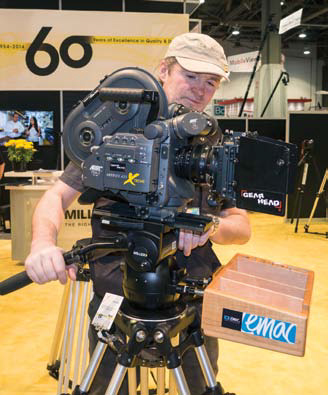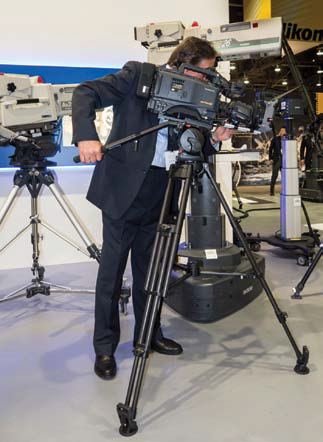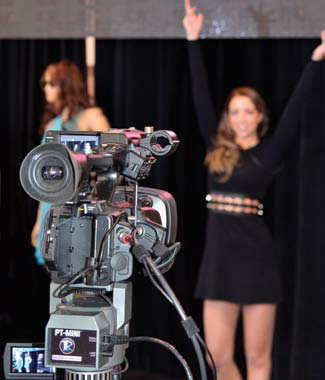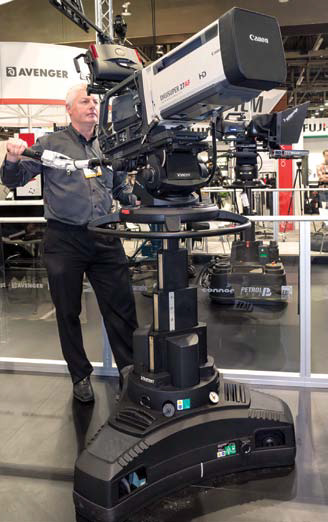NAB Show Product Review: Camera Support
During the short-lived 3D frenzy, camera support equipment makers were retooling their wares for the additional size and weight of camera/lens pairs locked in 3D rigs. 4G production doesn’t seem to need quite such high payload capabilities, and in fact the use of DSLRs has required support equipment that functions smoothly with minimal payloads.
TRIPODS
CARTONI debuted its Smart Pro fluid head for camera payloads up to 13 pounds. It features ergonomic knobs for ease-of-use, better control and a more fluid touch on drag and counterbalance. Also new is Cartoni’s compact and lightweight Stabilo, a three-stage, carbon fiber tripod that folds to 25 inches and extends to 72 inches.
DAVIS & SANFORD introduced the ProElite 6100-33 100mm ENG Tripod with a head that provides up to 33 pounds of payload, a six-position pan and tilt drag, including zero position, and a selectable seven-position counterbalance system including zero position. The Steady Stick 3QR with Quick-Release Plate System goes where tripods or monopods can’t be used. The Monopod with Folding Base has a 64-inch maximum height and 12 pound capacity.
David Wright with Nikon tries out the Miller Cineline 70 fluid head. LIBEC debuted its Allex camera support system, integrating tripod, fluid head and slider into a kit with dozens of possible configurations. The Allex T tripod has special footpads and leg stoppers, providing a rigid platform. The Allex H dual fluid head supports payloads up to 9 pounds and a tilt range of +90 degrees to –80 degrees. The Allex S slider has a 30-inch sliding range and requires no adapters to mount the slider between the tripod and fluid head.

MANFROTTO introduced its 504HD Crossover tripod system, with a fluid head featuring a wide top plate and long sliding plate for extra stability and balance while using video or photo equipment. It is engineered with a unique open center section that cuts down on weight, and a four-step counterbalance system ensures quick setup and optimal performance.
MILLER CAMERA SUPPORT unveiled its Cineline 70 Fluid Head, engineered for film and digital production cinematographers. It features an ARRI-sized side-loading camera platform, and when fitted with the company’s Mitchell Base Adaptor 1225, can be mounted on traditional Mitchell flat base tripods. The Cineline 70 provides seven (+ 0) positions of precision fluid drag and eight counterbalance settings, all located in one control layout for quick and easy setup.
The professional video industry's #1 source for news, trends and product and tech information. Sign up below.
OCONNOR featured its 60L carbon fiber tripod that proves a lightweight support option for the OConnor Ultimate 2065 and 2575D fluid heads. The tripod combines the benefits of new-age materials with precision engineering to provide a lightweight support system with torsional rigidity, fast setup, and can carry a camera configuration of up to 209 pounds.
SACHTLER expanded on its Ace tripod systems with Ace Accessories, which included the Ace Base Plate, Ace Follow Focus and Ace Matte Box, which can be bought individually or as a package. The company also debuted its Speedlevel Clamp for Sachtler’s range of 100mm heads, and has redesigned its Ace L fluid head to make it compatible with all types of sliders.

John O’Keefe uses a camera on a Shotoku SX300 fluid head and new carbon fiber legs.SHOTOKU unveiled its two-stage TTH1502C carbon-fiber tripod designed to provide a lightweight yet sturdy tripod system for EFP or documentaries. The 13-pound tripod features a 150mm bowl base, standing more than 5 feet tall at its maximum height. It is designed to be paired with Shotoku’s SX300 pan and tilt head.
VINTEN introduced its Vision blueBridge accessory, which extends the payload range of the company’s Vision blue pan and tilt heads. The studio and OB standby Vector 750 and 950 pan and tilt heads were shown in their standard and “i” versions, with an Intelligence Module and VRI box to provide precise positioning data possible from a pantographic head for virtual and augmented reality deployment.
CAMERA REMOTE CONTROL
CAMERA CORPS premiered its Q3 compact robotic head, building on the capabilities of the company’s prior Q2 robotic head. Refinements include a doubling of the zoom range, a new high-performance imager with nearly double the sensitivity, ultra- smooth pan/tilt/zoom, the ability to intercut with studio cameras, and a cue light.
CARTONI unveiled its E-REM 25 remote control head for cameras up to 55 pounds. It can be operated on pedestals, tripods or under-slung from cranes and is equipped with simple modular electronics, and gear mechanics.
REDROCK MICRO premiered its One Man Crew motorized parabolic motion system, with a motorized drive that guides the camera on precision-curved track at any speed desired, while keeping the subject stationary in frame. The company also showcased its RunningMan Rig, designed for run-and-gun operation with a DSLR.
ROSS VIDEO added its Furio Panbar remote camera controller to its rail-based remote camera system. The Panbar controller looks like a pan and tilt head, and makes controlling a Furio remote camera similar to running a manual camera. The company also featured its CamBot 700 Series, a fully robotic head and pedestal capable of handling camera payloads up to 200 pounds. The CamBot remote control equipment provides virtual reality positional encoding as an option.

Rushworks’ PT-Mini pan/tilt head was Instrumental in capturing a pose by Stephanie Furstahl at the Rushworks booth.RUSHWORKS introduced its CNRL R Touch Screen PTZ Camera Control Software and PT-Mini Compact Pan/Tilt Heads as part of its automated production system. These two products can be integrated with the Blackmagic Design ATEM Television Studio and HyperDeck recorders to provide a turnkey automated production capacity.
SHOTOKU, in partnership with ncam, introduced its Camera Tracking System. It features a multisensing bar unobtrusively mounted on the studio camera that provides real-time data to its associated tracking server, and provides complete eight-axis 3D positional information via industry-standard protocols compatible with any VR/AR graphics system.
TELEMETRICS instroduced its next generation Remote Camera Control System, purpose built and designed to extend workflow efficiencies for a wide range of networked or stand-alone camera automation applications. The system combines an intuitive and richly featured Robotic Camera Control Panel (RCCP-1) with the added convenience of a Camera Shader Panel (CSP) supported by Enterprise Database Control Software (EDCS). Also new is the TG4 Teleglide Camera Track System, which is smoother and quieter compared to previous and competitive systems and the new camera robotics Auto Tracking System (ATS), which is designed to follow one or more speakers as they move about the room. Telemetrics also debuted its Robo Eye integrated HD camera/robotic PTZ, which delivers HD imaging and high-end robotics performance in a single cost-effective package. Robo Eye provides out of the box operation for on-air and augmented reality systems.
VINTEN RADAMEC introduced its FPR- 210+ robotic pedestal, designed to handle head and camera package payloads up to 210 pounds, such as the company’s Fusion FH-145 head, plus the combined weight of the studio camera, studio lens and prompter/vanity monitor combination. Vinten Radamec also showed a delivering version of its APS (Absolute Positioning System) robotic pedestals, which rely on a pedestal-mounted laser to read targets placed throughout the studio in order to establish exact positioning.
STABILIZERS

Gregory Lundsgaard with Lundsgaard, ltd. tries out the Sachtler ACE and accessories.FREEFLY SYSTEMS added a new, larger stabilizer and controller to its MōVI handheld gyro stabilizer lineup. The MōVI M15 is designed for use with Sony’s F5/55, Red and ARRI Alexa M cameras. Existing MōVI M10s can be upgraded to the M15 model. The new controller provides not only control of pan, tilt, focus, iris and zoom, but also access to most of MōVI’s configuration settings.
GLIDECAM demonstrated its X-30 body-mounted stabilizer arm, featuring a dual section construction with a pair of titanium springs in each section, allowing separate tension adjustment for each. The X-30 arm is rated to carry 30 pounds.
TIFFEN’s Steadicam was shown with an operator on a Segway two-wheeled, self-balancing personal transport device. For use as a Steadiseg, the conventional Segway handlebars were replaced with a control-stick module between the knees, freeing the rider’s arms to operate camera stabilization systems. The addition of a hardmount assembly to support the Steadicam arm eliminates carrying strain, permitting bulky camera setups, such as IMAX cameras or 3D rigs, to be flown for extended periods without fatigue.
TELEPROMPTERS
AUTOCUE/QTV presented its DSLR 8 Prompter, designed specifically for DSLRs. The 8-inch prompter mounts to a standard set of 15 mm rails in front of the camera, allowing a user to mount a range of accessories onto the rails. The company also debuted iPad and Android prompting apps that turn tablets into prompters by combining them with Autocue’s 10-inch mounting hardware, hood and glass. Autocue also introduced its Master Series on-camera prompter monitors, and displayed an IP-based prompting system with the company’s QMaster/QBox. QMaster/QBox enables prompting over a network, over any distance, with the ability to feed scripts and live updates from a newsroom/ studio gallery to a prompter in the field.
AUTOSCRIPT launched WinPlus Remote, an iOS-based teleprompting system that delivers up-to-date scripts to users in the field, anywhere in the world. WinPlus Remote is installed on a networked PC in the production facility, allowing the latest version of the script to be seen by journalists on location. The software enables the script to be automatically uploaded to an FTP site where it can be downloaded onto an iPad by talent in the field and kept constantly updated.
CUESCRIPT unveiled its CSM17 17-inch LED High Brightness HD-SDI Prompter Monitor, designed with features including standard, built-in LED cue lights that offer LED adjustable brightness and 180-degree viewing.

Jed Wallace demonstrates the Vinten Vector 75 on a Quattro pedestalLISTEC showcased its Pro News Software, designed to integrate with MOS newsroom computer systems ENPS, Dalet, Inception, Octopus and iNews. It features Unicode construction to support languages, with WYSWYG point and click full-screen editing and is single- or multi-screen ready. The system offers an optional LT-HC/1 desktop controller with dedicated buttons for commonly needed tasks.
MIRROR IMAGE featured its IP-10 tele-prompting kit, which allows the user’s iPad tablet to be utilized as the monitor in the prompting system. The system includes a fully adjustable camera and tripod mount to fit any camera package. A wide-angle trapezoid beam splitter mirror allows the camera lens to be zoomed wide without vignetting on the prompting apparatus. Prompting apps are available for iPads or other tablet types.
EQUIPMENT BAGS
CINEBAGS introduced its CB11 Production Bag Mini, based on the Cinebags CB01 Production Bag. It provides the same functional features as its larger counterpart in a smaller package. Cinebags also featured its CB85 Slate Vault Pouch for Time Code Slate. It is designed to carry the Denecke TS-3 sized slates, the 13-inch MacBook and the 11- and 13- inch MacBook Air laptops.
MANFROTTO showcased four different lines of its bags: the Advanced, Professional, Professional Light and Professional Light Video. They feature tough exterior coverings, configurable protective interior dividers and rain covers.
PETROL BAGS introduced its Deca Airflow Camera Backpack, which features a rainbow shape to allow air flow-through to enhance comfort. It is designed for small cameras up to the Sony PMW-200 size.
PORTABRACE launched its Camera Hive Backpack & Slinger, designed with six padded 4-inch lens cups and six padded 7-inch lens cups as part of a removable interior honeycomb storage system that holds multiple lenses and accessories along with a DSLR. Portabrace also showed its Rib-8 carrying case, designed to protect cameras still mounted on a rig, which speeds the process of moving from location to location.
